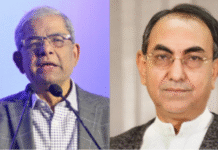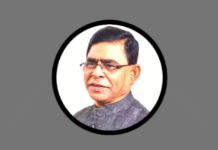Detectives detained Hefajat-e Islam leader and former state minister Mufti Mohammad Wakkas at the capital’s Malibagh yesterday in connection with Hefajat’s May 5 mayhem at Shapla Chattar.
Wakkas, Dhaka city unit vice-chairman of the organisation, was accused in 10 cases, including a murder case, sources at Dhaka Metropolitan Police said.
The cases were filed with Motijheel and Paltan police stations, sources added.
Wakkas would be shown arrested in the murder case, said a DB official, adding that he would be produced before a Dhaka court today.
Wakkas, also secretary general of Jamiat-e-Ulema-Islam, was picked up by a DB team of police around 2:30pm.
Ahlullah Wasel, press secretary of Hefajat’s Dhaka city unit, said law enforcers detained Wakkas from a meeting of Qawmi Madrasa Board.
In a statement last night, BNP Chairperson Khaleda Zia condemned the arrest and demanded his immediate release.
Khaleda, also chief of the 18-party alliance, said the arrest of Wakkas, a leader of the alliance, is part of the government’s “dirty game” to mislead the people and hide its “misrule.”
The government is using law enforcement agencies for torturing opposition men to silence its critics, she alleged.
During Hefajat’s May 5 rally at Shapla Chattar, Wakkas threatened to oust the government within that night.
Before the rally, thousands of Hefajat men had set fire to shops, police outposts and vehicles as the evening fell.
Wakkas, superintendent of Madaninagar Madrasa in Jessore, was elected lawmaker as an independent candidate from Monirampur (Jessore-5) in 1986.
After joining the Jatiya Party, he was made state minister for religious affairs in 1988 and later promoted to the post of whip of parliament during Ershad’s regime.
He formed Jamiat-e-Ulema-Islam in 1990 and has been holding the post of its secretary general since then.
Wakkas as a Jatiya Party candidate lost the 1991 and 1996 general elections. He was elected MP in 2001 from four-party alliance but he failed to win in 2008.
Source: UNBConnect










